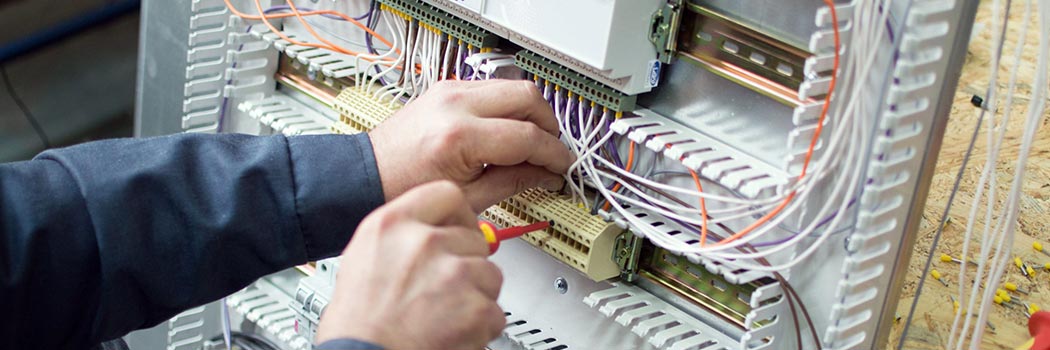Commercial electrical installations involve setting up electrical systems in commercial properties like offices, retail stores, restaurants, and industrial facilities. These installations need to be robust, efficient, and compliant with various regulations and codes.

Key Aspects of Commercial Electrical Installations
Here’s a comprehensive guide to commercial electrical installations:
Design and Planning:
- Load Calculation: Perform detailed calculations to determine the electrical load requirements based on the building’s use and equipment. This includes lighting, HVAC systems, machinery, and office equipment.
- Code Compliance: Ensure the design adheres to local, national, and international electrical codes and standards, such as the National Electrical Code (NEC) in the U.S.
- Energy Efficiency: Incorporate energy-efficient designs, including lighting and HVAC systems, to reduce operational costs and meet sustainability goals.
Electrical Distribution:
- Main Distribution Panel: Install a main distribution panel that feeds power to sub-panels throughout the building. This panel should be capable of handling the total load and include circuit breakers for protection.
- Sub-Panels: Use sub-panels to manage electrical distribution in different areas of the building, such as specific floors or departments.
- Busbars: Utilise busbars for efficient distribution of electrical power within the panels.
Lighting Systems:
- General Lighting: Implement efficient general lighting solutions for workspaces, including LED fixtures that provide adequate illumination and reduce energy consumption.
- Emergency Lighting: Install emergency and exit lighting systems to ensure safety during power outages or emergencies.
- Control Systems: Use advanced lighting control systems, such as dimmers and automated controls, to optimise energy use and adapt lighting to different needs.
Power Outlets and Circuits:
- Design Layout: Plan the placement of power outlets to accommodate the needs of various workstations, equipment and electrical appliances.
- Dedicated Circuits: Provide dedicated circuits for high-power equipment to prevent overload and ensure reliable operation.
HVAC Systems:
- Integration: Integrate HVAC systems with the electrical infrastructure to ensure efficient and reliable climate control. Include controls for temperature regulation, humidity control, and ventilation.
- Energy Management: Incorporate energy management systems to monitor and optimise HVAC performance in commercial applications.
Data and Communication Systems:
- Structured Cabling: Install structured cabling systems for data networks, including Ethernet, telephone lines and fiber optics.
- Networking Equipment: Ensure proper setup for networking equipment, including servers, routers and switches.
- Integration: Integrate communication systems with the building’s electrical infrastructure for seamless operation.
Safety and Compliance:
- Circuit Protection: Install circuit breakers, fuses, and surge protectors to safeguard against electrical faults and surges.
- Grounding and Bonding: Ensure proper grounding and bonding of electrical systems to enhance safety and reduce the risk of electrical shock.
- Regular Inspections: Schedule regular inspections and maintenance to ensure ongoing safety and compliance with regulations.
Backup Power Systems:
- Generators: Install standby generators to provide backup power in case of outages, ensuring business continuity.
- Uninterruptible Power Supplies (UPS): Use UPS systems for critical equipment to protect against short-term power interruptions.
Energy Management and Efficiency:
- Smart Controls: Implement smart energy management systems to monitor and control energy usage across the building.
- Energy Audits: Conduct energy audits to identify opportunities for efficiency improvements and cost savings.
Security Systems:
- Surveillance: Install CCTV cameras and surveillance systems for monitoring and security.
- Access Control: Set up access control systems, including keypads, card readers, and biometric scanners, to manage building access.
Steps in Commercial Electrical Installation
Pre-Installation Planning:
- Consultation: Work with architects, engineers, and contractors to plan the electrical system design.
- Permits: Obtain necessary permits and approvals from local authorities.
Installation:
- Rough-In: Begin with rough-in work, including running conduits, wiring, and installing electrical boxes.
- Panel Installation: Install the main distribution panel and sub-panels.
- Wiring: Complete the wiring for outlets, lighting, and equipment according to the design.
Finalisation:
- Fixture Installation: Install lighting fixtures, outlets, and other electrical devices.
- System Testing: Test the electrical system for functionality, safety, and compliance.
Inspection and Certification:
- Inspections: Schedule inspections with local authorities to ensure the installation meets all codes and standards.
- Certification: Obtain certification and approvals as required.
Training and Handover:
- Training: Provide training for facility management staff on operating and maintaining the electrical systems.
- Documentation: Hand over all documentation, including schematics, warranties, and maintenance instructions.
Benefits of a High-Quality Commercial Electrical Installation
- Reliability: Reduces the risk of electrical failures and downtime, ensuring smooth operation of business activities.
- Safety: Enhances safety for employees and customers by adhering to high standards and regulations.
- Efficiency: Improves energy efficiency, leading to cost savings and a smaller environmental footprint.
- Scalability: Allows for future expansion and upgrades with minimal disruption.
High-quality commercial electrical installations are crucial for the effective operation of a business. By focusing on design, safety, and efficiency, you can ensure that your electrical systems meet the needs of your commercial property while adhering to all relevant standards and regulations.
For over 39 years David Anderson Electrical designed and installed electrical systems in many Commercial Projects. The quality of workmanship has stood the test of time. Quality installations that provide long term value for money. Projects include, Clubs, Hotels, Quarries, Commercial Retail Buildings.
